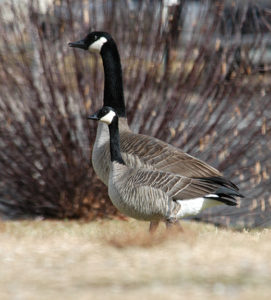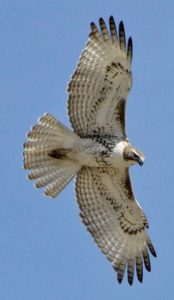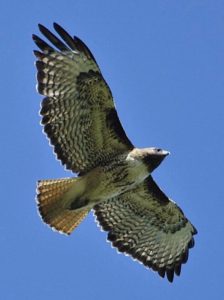The weather was surprisingly mild for early December, and though we started out with our coats on it was not long before several of us were down to shirtsleeves. November can be a good time to start seeing a wide variety of wintering geese and ducks, and while we had good luck getting three species of geese, Snow, Cackling, and Canada, we only came away with three species of ducks which is below what one might expect this time of year. The high number of Mallards, almost 300, was most impressive.
We managed to do well with the raptors. We saw four Red-tails, and even though they were all our usual light plumaged western morph, there was good variety in their appearance. There was a juvenile with a banded tail, and an adult with a “red” tail; some had more white on the scapulars, and others had less; some had a more obvious belly-band, others less so; and so it went. One thing to start looking for in your Red-tails is whether they have a dark chin and throat (our western birds), or whether they have a white chin and throat (Eastern birds). Living where we do at the foot of the Rockies – where East meets West – we are in a region where we find eastern and western forms of many species.
As for our other raptors we had a distant, silhouetted view of a Prairie Falcon perched high on a pole – a bit more slender than a Buteo (the genus of soaring hawks), with a longer tail, and overall rather pale looking. We had a great look at a Northern Harrier cruising low over the fields and wetlands – a slender bird with a long, banded tail, and long wings raised in a dihedral; and the white rump is always obvious. And then we had another falcon, an American Kestrel, with beautiful rufous barring on her back.
A few other highlights were provided by a good number of American Tree Sparrows, and then we had three races of Dark-eyed Juncos: Slate-colored, Oregon, and Pink-sided. There are six races that occur around here in the winter, and it can be fun (and challenging) to sort them out. At one time, they were considered to all be distinct species, but for now they have been lumped together as Dark-eyed Juncos.
We hope to see you on another walk soon!
Chuck and David
Denver Botanic Gardens at Chatfield, Dec 2, 2017
28 species
Snow Goose (Anser caerulescens) 1
Cackling Goose (Branta hutchinsii) 12
Canada Goose (Branta canadensis) 1500
Gadwall (Mareca strepera) 2
American Wigeon (Mareca americana) 3
Mallard (Anas platyrhynchos) 290
Great Blue Heron (Ardea herodias) 3
Northern Harrier (Circus hudsonius) 1
Red-tailed Hawk (Buteo jamaicensis) 4
Rock Pigeon (Feral Pigeon) (Columba livia (Feral Pigeon)) 72
Eurasian Collared-Dove (Streptopelia decaocto) 10
Downy Woodpecker (Picoides pubescens) 4
Northern Flicker (Colaptes auratus) 4
American Kestrel (Falco sparverius) 1
Prairie Falcon (Falco mexicanus) 1
Black-billed Magpie (Pica hudsonia) 13
American Crow (Corvus brachyrhynchos) 112
Black-capped Chickadee (Poecile atricapillus) 6
White-breasted Nuthatch (Sitta carolinensis) 3
Brown Creeper (Certhia americana) 1
Townsend’s Solitaire (Myadestes townsendi) 1
American Robin (Turdus migratorius) 4
American Tree Sparrow (Spizelloides arborea) 14
Dark-eyed Junco (Junco hyemalis) 4
Dark-eyed Junco (Slate-colored) (Junco hyemalis hyemalis/carolinensis) 5
Dark-eyed Junco (Oregon) (Junco hyemalis [oreganus Group]) 7
Dark-eyed Junco (Pink-sided) (Junco hyemalis mearnsi) 1
Song Sparrow (Melospiza melodia) 1
Red-winged Blackbird (Agelaius phoeniceus) 193
House Finch (Haemorhous mexicanus) 71
American Goldfinch (Spinus tristis) 5






Comments
Write Comment